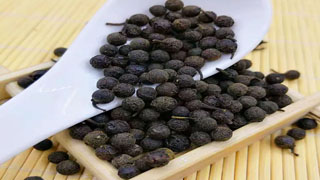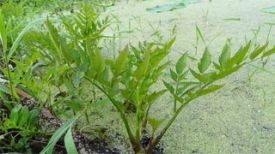
1. Alias
Chengqie, Bichengqie, Biqie, Shanpepper, Chilizi, Shancangzi, Mujiangzi, Stinky Camphor.
2. Plant morphology
Shrubs or small trees. 3-10 meters high, with a strong aroma. The bark is gray brown, and the small branches are green. Leaves alternate, thin papery, lanceolate or oblong in shape, with slender petioles. Dioecious, with a cluster of umbrella shaped inflorescences growing in bundles at the leaf axils. The leaves open first, with slender total flower stems, 4 total bracts, and 4-6 flowers; Flower petals with 6 lobes, inverted in shape; Male flowers have a diameter of about 3 millimeters, 9 stamens, inward, 3 whorls, with 3 stamens per round. In the third round, there are 2 glands at the base of the stamens, 4 anthers, lobed petals, and a degenerated pistil in the center; The diameter of female flowers is about 2 millimeters, the ovary is ovate, the style is short, the stigma is head shaped, and there are 6-12 degenerated stamens, which are tongue shaped. Berry like drupe, nearly spherical, diameter 4-6 millimeters, black when ripe, stem length 3-5 millimeters, total stem length 7-10 millimeters. Seeds have ridges. The flowering period is from April to May, and the fruiting period is from July to November.
3. Origin distribution
Born on sunny slopes, forest edges, and shrubs. Distributed in Jiangsu, Zhejiang, Yunnan and other places.
4. Harvesting and processing
Harvest the fruits in autumn when they are ripe, remove impurities, and dry them in the sun.
5. Characteristics of medicinal herbs
Spherical in shape, with a diameter of 4-6 millimeters. The surface is brown to dark brown with reticular wrinkles. Occasionally, there are persistent sepals and slender fruit stalks at the base. Excluding the visible hard and brittle core on the outer skin, there is one seed and two cotyledons, which are yellow brown and rich in oil. It has a fragrant aroma and a slightly spicy and bitter taste. Take 1.5-3g orally and decoct the soup.
6. Sexual Taste Returning to the Classics
Warm in nature, pungent in taste. Guipi Meridian, Stomach Meridian, Kidney Meridian, Bladder Meridian.
7. Effect and Function
Warm and dispel cold, promote qi circulation and relieve pain. Belonging to Wenli medicine.
8. Clinical application
Take 1.5 to 3 grams of decoction orally. Used to treat stomach cold vomiting, abdominal cold pain, cold hernia, abdominal pain, cold dampness, and cloudy urine.
9. Pharmacological research
It has the functions of regulating gastrointestinal motility, anti gastric ulcer, sedation, analgesia, and antibacterial. Pharmacological experiments have shown that volatile oils have the effects of relaxing tracheal smooth muscle and relieving asthma; It has an inhibitory effect on passive skin allergic reactions; It has a local irritant effect on the mucosa and can be absorbed, and can also exert this effect on the mucous membranes of the urinary tract and respiratory tract; Oral administration of its volatile oil has certain preservative effects on the urinary tract.
10. Chemical composition
Containing volatile oil, the main components of the oil are citral, methyl heptene, linalool, limonene, citral, camphene, α - pinene, and camphene. In addition, it also contains citral, magnolol, fatty oil, and a small amount of limonene.
11. Usage taboos
Yin deficiency with heat in the blood, fever and cough are prohibited.
12. Compatibility prescription
① Treatment for gastric persimmon stone syndrome: 5 grams each of Bi Cheng eggplant, Wu Zhu yu, and Ji Nei Jin, 10 grams each of dried ginger, cooked aconite, tangerine peel, betel nut, radish, wood fragrance, triangular root, and zedoary turmeric, 20 grams each of roasted hawthorn and Salvia miltiorrhiza, and 3 grams of indigo naturalis. Boil in water and take 1 dose daily. External application formula: Apply an appropriate amount of skin nitrate (depending on the size of the stone), use a cotton bag, and apply it externally to the epigastric region, changing once a day. 20 cases were treated and all were cured. The treatment course was 10 days for the elderly (10 cases) and 6 days for the short (10 cases), with an average of 8 days Zhejiang Journal of Traditional Chinese Medicine, 1990; 25 (10): 441
② Treating spleen and stomach weakness, chest and diaphragm discomfort, and not eating: no matter how much is used, there is no limit to the amount of eggplant. To make a fine powder, ginger juice is mixed with Shenqu powder and cooked into balls, like the size of tung seeds. Seventy pills per meal, served in light ginger soup. (Ji Sheng Fang Bi Cheng Jia Wan)
③ For those who treat typhoid fever day and night, three parts of Bi Cheng eggplant and three parts of Gao Liang Jiang are used. Two things are crushed into powder. Take for two yuan per serving, add six minutes of water, boil for more than ten minutes, add a little vinegar and stir well, mix with the dregs like tea, and sip hot. (Compendium of Materia Medica)
⊙ The content of the article is for clinical reference only. Non TCM professionals are not allowed to test drugs.


